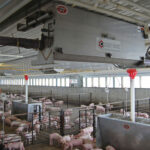Small Hay, Big Needs
Most days, from 5 a.m. to 1:30 p.m., you can find Galen Hammann working what might be called his first shift. He’s an assistant engineer at the Truman Hotel in his hometown of Jefferson City, Mo. By mid-afternoon, he’s working...
Small Hay, Big Needs
Most days, from 5 a.m. to 1:30 p.m., you can find Galen Hammann working what might be called his first shift. He’s an assistant engineer at the Truman Hotel in his hometown of Jefferson City, Mo. By mid-afternoon, he’s working...Most days, from 5 a.m. to 1:30 p.m., you can find Galen Hammann working what might be called his first shift. He’s an assistant engineer at the Truman Hotel in his hometown of Jefferson City, Mo.
By mid-afternoon, he’s working closer to home on his 185-acre farm, where he raises about 80 head of cattle a year, as well as oats, wheat and hay—a mixture of fescue, orchardgrass, brome and clover—to use as feed for his cow/calf operation. No matter what he’s up to, the work usually doesn’t stop until dark, if not later.
That’s much the same story for Ken Thalman. Living and working about a three-hour drive east from Hammann, Thalman is a full-time postal employee in Centralia, Ill., who, in addition to his day job, grows grass hay on 18 acres of his 40-acre spread.
Thalman and Hammann are among the growing ranks of the do-it-yourself hay producers. One of the main drivers of the trend is that less hay is being produced, leading to higher prices.
Also, significant advances in equipment have made it more cost-effective for many farmers to grow their own as opposed to buying feed or hiring custom harvesters. Even growing hay on plots of land once considered too small to be worth the effort has become an increasingly popular solution for producers looking to squeeze the value out of every dollar, hour and acre.
To be sure, the rising cost of hay and the demand on custom harvesters have made the DIY option more cost-effective for greater numbers of small-acreage farmers. In addition, not only can they now grow hay themselves, small-acreage producers can also grow the quality their operations demand.
Both Hammann and Thalman battle hills and sharp corners that make operating with large mowers and balers difficult. That’s a big reason why they use small, nimble equipment that’s more suited for rolling land often carved into small parcels.
“The smaller length of the cutterbar on Ken’s Massey Ferguson® 1326 disc mower allows it to cover rough terrain,” says dealer Jeff Suchomski, of Suchomski Equipment. “And Ken’s Hesston® 1734 [round] baler, with the smaller overall size, can handle the terrain better too.”
Thalman can also pull his new equipment with relatively low-horsepower tractors. Considering many small-acreage farmers aren’t likely to own anything much larger, that’s a valuable feature.
“I don’t need a big tractor [for] farming,” says Thalman. “I’ve got my own tractor, and Jeff can match me up with equipment that will work with what I’ve got. It’s a win-win situation.”
Both Thalman and Hammann also have to travel over the road with their equipment to reach smaller patches of land they clear for neighbors. When he needs to be mobile, Hammann runs a Hesston 4550 square baler he purchased from Tom Lauf, of Lauf Equipment. “The square baler is built very compact compared to how it used to be built. It’s narrower and still makes a better bale than the old balers did,” Lauf says.
Thalman also likes the way his equipment handles in tight spots. “When I show you some of the places that I take hay off of, you’d think there’s no way you could get your equipment in,” he says. “I’ve got places up and down the road here with 4, 5 and 6 acres that I mow. And my equipment is small enough, I can just run right down the road.”
Read the full story at http://www.myfarmlife.com/features/small-hay-operations-have-big-needs/.





